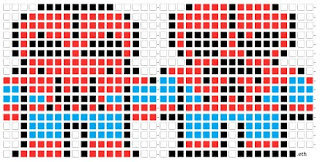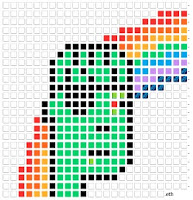BLOG POST
One of the most significant findings from our recent analyses of blockchain domain names[1] is the emergence of a new style of 'artwork' domain names. This is where the characters of the domain name itself take the form of a pixelated artwork, when the name is displayed in a suitable grid. This may represent a new use-case for blockchain domain names, outside their more familiar applications as the basis for cryptocurrency wallet addresses and for the hosting of decentralised websites, moving more into the realm of 'tradeable' names similar to NFTs.
We have conducted a study of the set of long (>100 character) .eth blockchain domain names registered in the 120-day period to the start of November 2023, to analyse any new trends in artwork domain names during this time.
Amongst the registrations, a number of artwork examples appear, including a new series of 'CryptoPunk'-style images (which may be infringing the NFT collection owned by Yuga Labs), and a group of graphical domain names terminating with 'ensart.eth', which may represent a specific tradeable set or a collection produced by an individual artist.
One specific trend is the appearance of artwork domain names featuring lettering ('pseudo-logos'). It may be the case that, going forward, we see a new type of infringement, where company logos or other branded imagery could appear in graphical blockchain domain names themselves. This would mean the emergence of a new class of cybersquatting. Consequently, there may be a need for brand owners to be mindful of this space, which may require the development of new monitoring technologies. This may also present a call for novel enforcement procedures (and potentially also changes to regulation or legislation) to address these infringements.
Reference
[1] https://www.iamstobbs.com/trends-in-web3-ebook
This article was first published on 6 December 2023 at:
* * * * *
WHITE PAPER
Introduction
In our most recent analyses of blockchain domain names[1] - i.e. domains based on Web3 concepts, and utilising the same underlying blockchain technologies as cryptocurrencies such as Bitcoin - we discussed the emergence of what appears to be a new use-case for these domain names. Amongst the differences between blockchain domains and their older Web2 ('classic' domain name) counterparts are the facts that blockchain domain names can be considerably greater in length, and can include special characters such as emojis. Consequently, aside from their more familiar applications, as the basis for memorable cryptocurrency wallet addresses and for the hosting of decentralised websites, there is a growing number of instances where the domain name itself is constructed using characters such as coloured squares (e.g. ⬛ and ⬜ ) such that, when the domain name is displayed in a suitable grid, it takes the form of a pixellated artwork. It appears that the intention is for these blockchain domains to be 'tradeable' in the same way as NFT artworks, and may reflect a new aspect to the monetisation of Web3 content and collectible domain 'clubs'.
In this follow-up, we conduct an inspection of the new .eth blockchain domain names (based on the same blockchain as the Ethereum cryptocurrency) which have been registered via the Ethereum Name Service ('ENS') in the 120-day period to the start of November 2023 (i.e. essentially covering the period since the dataset used in the previous studies), again using data from Dune Analytics[2].
Analysis
Over 161,000 new .eth domain names have been registered through ENS during this 3-month period. Of these, 56 examples were found to have long (greater than 100 characters) second-level domain names (SLDs) (i.e. the part of the domain name to the left of the dot) - the subset most likely to be utilised in the construction of artworks. Some of these long domain names consist purely of text characters, mostly comprising repetitive[3], nonsensical[4], or other text[5], whilst some appear to constitute readable messages or instructions (and may be associated with scams) - e.g. read-mei-want-to-return-some-funds-stolen-in-2021-send-anemail-to-this-address-recovermy2021funds--atsign--proton-dot-me.eth. In most of these cases, the intention seems for the domain name itself to be meaningful, rather than necessarily being associated with any underlying website.
Similarly, a number of new examples of artwork domain names were also identified. The domain names generally seem to either require the characters to be laid out in a (fixed-character-width) square grid, or incorporate specific characters denoting where the line-breaks need to be placed, in order for the artwork to be apparent. Some examples are shown in Figures 1 and 2.
Figure 1: Examples of artwork blockchain domain names (with SLD lengths (in characters) of 1,636, 643 and 597)
Figure 2: Examples of 'CryptoPunk'-style artwork blockchain domain names (all with SLD lengths of 597 or 596 characters)
As with the similar examples discussed previously, the domains in Figure 2 appear similar to the images in the CryptoPunks NFT collection (owned by Yuga Labs), and may therefore be infringing intellectual property. Similar comments may apply to other examples in the previous analysis, which included apparent images of Pokémon, Donkey Kong and Super Mario characters.
One new development in the most recent set of registrations is the appearance of a group of artwork domain names terminating with the string 'ensart.eth' (presumably a reference to Ethereum Name Service) and perhaps representing a specific tradable set of domain names, or a collection produced by an individual artist. It is also noteworthy that the collection includes examples featuring 'pseudo-logos', displaying the names 'ENS' and 'GM' (Figure 3).
Figure 3: Examples of artwork blockchain domain names from the 'ENSart.eth collection' (all with SLD lengths of 169 characters)
It is also noteworthy that there exists, on the cryptocurrency-trading website Coinbase, a profile for an individual with a username also ending with 'ensart.eth' and incorporating a similar style of artwork, and who may therefore be associated with the collection shown in Figure 3. This individual's Coinbase username[6] displays a 'portrait' when displayed in a grid of width 14 characters (Figure 4).
Figure 4: Artwork username for a profile on Coinbase
Discussion
The examples identified in this study highlight the growing importance of the development of brand-protection technologies to allow brand owners to detect and analyse the content of blockchain domain names. These tools are likely to require the incorporation of image analysis to identify instances where branded imagery or logos are represented within the domain names themselves.
Some progress in the evolution of enforcement procedures to address these types of infringements is also likely to be required.
Looking further ahead, it is also possible that (depending on how blockchain domains become more widely natively supported in mainstream web browsers - both in terms of their ability to resolve any associated website content, and the way in which the domain names themselves are interpreted and displayed), we may also see a growth in the adoption of these types of graphical domain names by legitimate brand owners. For example, we can imagine a use-case where (say) Stobbs could register an appropriate blockchain domain name[7] which, when displayed in a suitable grid, displays a company logo (Figure 5) and, when visited in a supported web browser, resolves to (a decentralised version of?) the Stobbs official website.
Figure 5: Mock-up of a possible artwork blockchain domain name incorporating a Stobbs company logo
References
[1] https://www.iamstobbs.com/trends-in-web3-ebook
[2] https://dune.com/queries/7507/14878
[3] e.g. mmmmmmmmmmmmmmmmmmmmmmmmmmmmmmmmmmmmmmmmmmmmmmmmmmmmmmmmmmmmmmmmmmmmmmmmmmmmmmmmmmmmmmmmmmmmmmmmmmmmmmmmmmmmmmmmmmmmmmmmmmmmmmmmmmmmmmmmmmmmmmmmmmmmmmmmmmmmmmmmmmmmmmmmmmmmmmmmmmmmmmmmmmmmmmmmmmmmmmmmmmmmmmmmmmmmmmmmmmmmmmmmmmmmmmmmmmmmmmmmmmmmmmmmmmm.eth - 251 characters
[4] e.g. minitubbahubbabubbahubbatubbahubbabubbabubbahubbahubbabubbatubbabubbahubbabubbatubbatubbatubbabubbahubbabubbatubbabubbahubbabubbahubbahubbatubbabubbatubbatubbahubbahubbatubbabubbabubbatubbabubbahubbahubbabubba.eth - 209 characters
[5] e.g. honoredtohavethegenerationalopportunitytobuyandholdrealgoldthankyouhumpyandteamfortheworkyouhavedoneinpreparationandwillcontinuedoingtoletmerideyourbacktoon-chainglory.eth - 167 characters
[6] Username: ⬛⬛⬛⬛⬛🟫🟫🟫🟫⬛⬛⬛⬛⬛⬛⬛⬛⬛🟫🟫🟫🟫🟫🟫⬛⬛⬛⬛⬛⬛⬛🟫🏼 🟫🟫🏼 🟫⬛⬛⬛⬛⬛⬛🟫🏼 🟫⬛⬛⬛⬛🏼 🟫🏼💲🏼 💲🏼🟫🏼 ⬛⬛🏼 ⬛⬛⬛⬛🏼⬜⬜⬜⬜⬜⬜🏼⬛⬛⬛⬛⬛⬛🏼🟥🟥🟥🟥🟥🟥🏼⬛⬛⬛⬛⬛⬛🏼 ⬜⬜⬜⬜🏼 ⬛⬛⬛⬛⬛⬛⬛🏼⬛⬛⬛⬛⬛⬛⬛⬛⬛⬛⬛⬛⬛⬛⬛⬛⬛⬛ponzidao⬛⬛⬛⬛ensart.eth
[7] e.g. ⬜⬜⬜⬜⬜⬜⬜⬜⬜⬜⬜⬜⬜⬜⬜⬜⬜⬜⬜⬜⬜⬜⬜⬜⬜⬜⬜⬜⬜⬜⬜⬜⬜⬜⬜⬜⬜⬜⬜⬜⬜⬜⬜⬜⬜⬛⬛⬛⬛⬛⬜⬜⬜⬜⬜⬜⬜⬜⬜⬜⬜⬜⬜⬜⬜⬜⬜⬜⬜⬜⬜⬜⬜⬜⬜⬛⬛⬛⬛⬛⬛⬛⬜⬜⬜⬜⬜⬜⬜⬜⬜⬜⬜⬜⬜⬜⬜⬜⬜⬜⬜⬜⬜⬜⬜⬛⬛⬛⬜⬜⬜⬜⬛⬛⬜⬜⬜⬜⬜⬜⬜⬜⬜⬜⬜⬜⬜⬜⬜⬜⬜⬜⬜⬜⬜⬛⬛⬛⬜⬜⬜⬜⬜⬜⬛⬛⬜⬜⬜⬜⬜⬜⬜⬜⬜⬜⬜⬜⬜⬜⬜⬜⬜⬜⬜⬜⬛⬛⬜⬜⬜⬜⬜⬜⬜⬛⬛⬜⬜⬜⬜⬜⬜⬜⬜⬜⬜⬜⬜⬜⬜⬜⬜⬜⬜⬜⬜⬛⬛⬜⬜⬜⬜⬜⬜⬜⬛⬛⬜⬜⬜⬜⬜⬜⬜⬜⬜⬜⬜⬜⬜⬜⬜⬜⬜⬜⬜⬜⬛⬛⬜⬜⬜⬜⬜⬜⬜⬛⬛⬜⬜⬜⬜⬜⬜⬜⬜⬜⬜⬜⬜⬜⬜⬜⬜⬜⬜⬜⬜⬛⬛⬜⬜⬜⬜⬜⬜⬛⬛⬛⬜⬜⬜⬜⬜⬜⬜⬜⬜⬜⬜⬜⬜⬜⬜⬜⬜⬜⬜⬜⬜⬛⬛⬜⬜⬜⬜⬛⬛⬛⬜⬜⬜⬜⬜⬜⬜⬜⬜⬜⬜⬜⬜⬜⬜⬛⬛⬛⬛⬛⬜⬜⬜⬛⬛⬛⬛⬛⬛⬛⬜⬜⬜⬛⬛⬛⬛⬛⬜⬜⬜⬜⬜⬜⬜⬛⬛⬛⬛⬛⬛⬛⬜⬜⬜⬛⬛⬛⬛⬛⬛⬜⬜⬛⬛⬛⬛⬛⬛⬛⬜⬜⬜⬜⬜⬛⬛⬜⬜⬜⬜⬛⬛⬛⬛⬜⬜⬜⬜⬛⬛⬜⬜⬛⬛⬜⬜⬜⬜⬛⬛⬛⬜⬜⬜⬛⬛⬜⬜⬜⬜⬜⬜⬛⬛⬛⬛⬜⬜⬛⬛⬜⬜⬛⬛⬜⬜⬜⬜⬜⬜⬛⬛⬛⬜⬜⬛⬛⬜⬜⬜⬜⬜⬜⬜⬛⬛⬛⬛⬛⬛⬛⬜⬜⬛⬛⬜⬜⬜⬜⬜⬜⬜⬛⬛⬜⬜⬛⬛⬜⬜⬜⬜⬜⬜⬜⬛⬛⬜⬛⬛⬛⬛⬛⬜⬛⬛⬜⬜⬜⬜⬜⬜⬜⬛⬛⬜⬜⬛⬛⬜⬜⬜⬜⬜⬜⬜⬛⬛⬜⬜⬛⬛⬛⬛⬛⬛⬛⬜⬜⬜⬜⬜⬜⬜⬛⬛⬜⬜⬛⬛⬛⬜⬜⬜⬜⬜⬜⬛⬛⬜⬜⬛⬛⬜⬜⬛⬛⬛⬛⬜⬜⬜⬜⬜⬜⬛⬛⬜⬜⬜⬛⬛⬛⬜⬜⬜⬜⬛⬛⬜⬜⬛⬛⬜⬜⬜⬜⬛⬛⬛⬛⬜⬜⬜⬜⬛⬛⬜⬜⬜⬜⬜⬛⬛⬛⬛⬛⬛⬛⬜⬜⬛⬛⬛⬛⬛⬛⬜⬜⬜⬛⬛⬛⬛⬛⬛⬛⬜⬜⬜⬜⬜⬜⬜⬛⬛⬛⬛⬛⬜⬜⬜⬛⬛⬛⬛⬛⬛⬛⬜⬜⬜⬛⬛⬛⬛⬛⬜⬜⬜⬜⬜⬜⬜⬜⬜⬜⬜⬜⬜⬜⬜⬛⬛⬛⬜⬜⬜⬜⬛⬛⬜⬜⬜⬜⬜⬜⬜⬜⬜⬜⬜⬜⬜⬜⬜⬜⬜⬜⬜⬜⬜⬛⬛⬛⬜⬜⬜⬜⬜⬜⬛⬛⬜⬜⬜⬜⬜⬜⬜⬜⬜⬜⬜⬜⬜⬜⬜⬜⬜⬜⬜⬜⬛⬛⬜⬜⬜⬜⬜⬜⬜⬛⬛⬜⬜⬜⬜⬜⬜⬜⬜⬜⬜⬜⬜⬜⬜⬜⬜⬜⬜⬜⬜⬛⬛⬜⬜⬜⬜⬜⬜⬜⬛⬛⬜⬜⬜⬜⬜⬜⬜⬜⬜⬜⬜⬜⬜⬜⬜⬜⬜⬜⬜⬜⬛⬛⬜⬜⬜⬜⬜⬜⬜⬛⬛⬜⬜⬜⬜⬜⬜⬜⬜⬜⬜⬜⬜⬜⬜⬜⬜⬜⬜⬜⬜⬛⬛⬜⬜⬜⬜⬜⬜⬛⬛⬛⬜⬜⬜⬜⬜⬜⬜⬜⬜⬜⬜⬜⬜⬜⬜⬜⬜⬜⬜⬜⬜⬛⬛⬜⬜⬜⬜⬛⬛⬛⬜⬜⬜⬜⬜⬜⬜⬜⬜⬜⬜⬜⬜⬜⬜⬜⬜⬜⬜⬜⬜⬜⬜⬛⬛⬛⬛⬛⬛⬛⬜⬜⬜⬜⬜⬜⬜⬜⬜⬜⬜⬜⬜⬜⬜⬜⬜⬜⬜⬜⬜⬜⬜⬜⬜⬛⬛⬛⬛⬛⬜⬜⬜⬜⬜⬜⬜⬜⬜⬜⬜⬜⬜⬜⬜⬜⬜⬜⬜⬜⬜⬜⬜⬜⬜⬜⬜⬜⬜⬜⬜⬜⬜⬜⬜⬜⬜⬜⬜⬜⬜⬜⬜⬜.eth - 961 characters
This paper was first published as an e-book on 6 December 2023 at:


















No comments:
Post a Comment